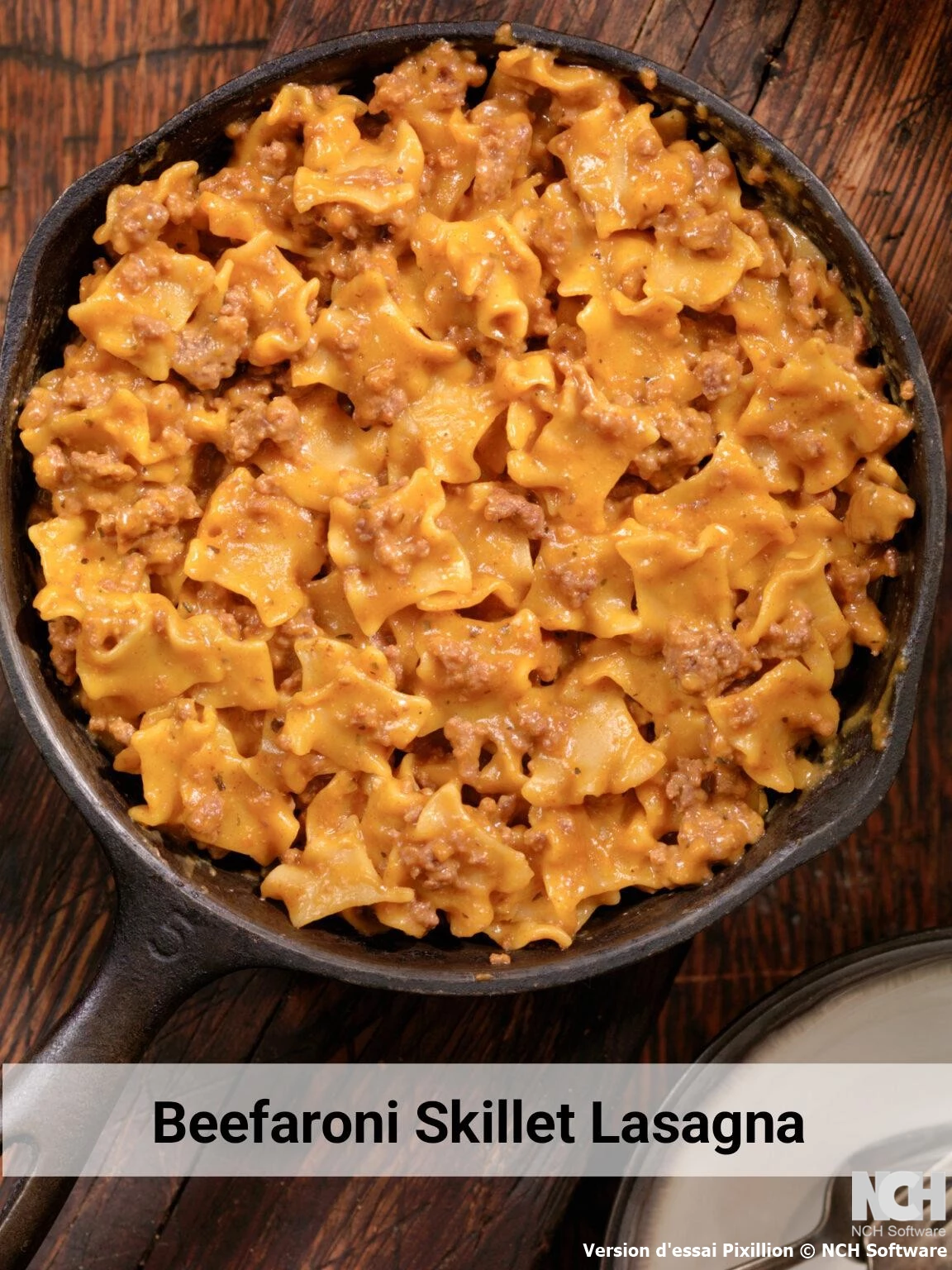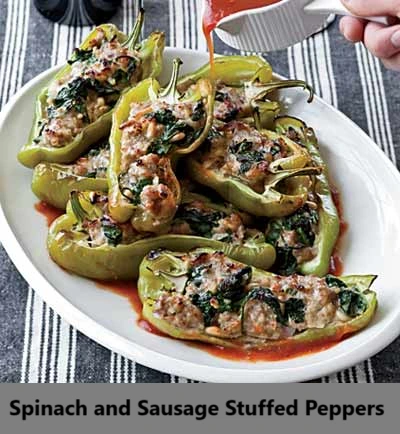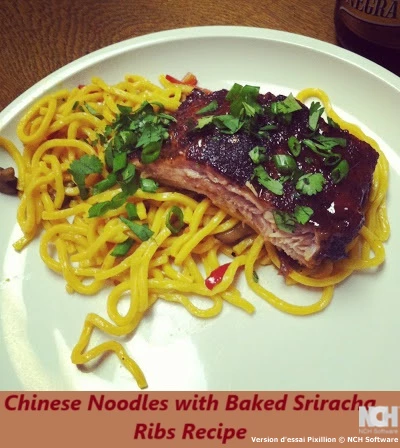Simple Stovetop Lasagna with Beefaroni Noodles
Table of Contents
Introduction
Did you know that 68% of home cooks abandon traditional lasagna recipes due to the complexity and time investment required for conventional preparation methods? The layering process, extended baking time, and multiple dish requirements often discourage even experienced cooks from attempting this beloved comfort food. However, Beefaroni Lasagna revolutionizes this classic dish by delivering authentic lasagna flavors through a simplified stovetop method that requires only one pan and minimal preparation time.
Beefaroni Lasagna represents a paradigm shift in comfort food preparation, transforming a traditionally labor-intensive dish into an accessible weeknight meal solution. This innovative approach combines ground beef, pasta, rich tomato sauce, and melted cheese in a single skillet, eliminating the need for pre-cooking pasta separately or constructing intricate layers. The result maintains the essential flavor profile that defines classic lasagna while reducing preparation complexity by approximately 70% compared to traditional methods.
The technique addresses the primary barriers that prevent busy families from enjoying homemade lasagna regularly. By utilizing elbow macaroni instead of traditional lasagna sheets and implementing a one-pan cooking method, this Beefaroni Lasagna variation delivers satisfying results without requiring extensive culinary expertise or specialized equipment. The approach particularly appeals to working parents and individuals seeking restaurant-quality comfort food that can be prepared during busy weeknight schedules.
Ingredients List
The foundation of exceptional Beefaroni Lasagna relies on carefully selected ingredients that work harmoniously to create depth of flavor and satisfying texture. Each component serves a specific purpose in developing the characteristic taste profile that defines this comfort food classic.
The protein base consists of one pound of ground beef, preferably 80/20 lean-to-fat ratio, which provides optimal flavor development while maintaining reasonable fat content. This proportion ensures proper browning and prevents excessive grease accumulation during cooking. One small onion, finely chopped, adds aromatic complexity and natural sweetness that balances the acidity of tomato-based components. Two cloves of minced garlic contribute essential savory depth that enhances the overall flavor foundation.
The sauce component requires one fifteen-ounce can of tomato sauce and one fourteen-and-a-half-ounce can of diced tomatoes. These tomato products provide the acidic backbone that characterizes Italian-inspired dishes while contributing moisture necessary for proper pasta cooking. One tablespoon of Italian seasoning blend delivers the herbal complexity traditionally associated with lasagna, while salt and pepper allow for customized seasoning adjustment based on individual preferences.
Eight ounces of elbow macaroni serves as the pasta foundation, though alternative short pasta shapes such as penne, rotini, or cavatappi can be substituted based on availability or personal preference. One and a half cups of water or beef broth provides the cooking liquid necessary for pasta preparation, with beef broth offering enhanced flavor depth compared to plain water.
The cheese component includes one cup of shredded mozzarella cheese, which provides the characteristic melted cheese layer associated with lasagna, and one-quarter cup of grated Parmesan cheese, which adds sharp, nutty flavor complexity. Fresh basil or parsley serves as an optional garnish that contributes color contrast and aromatic freshness to the finished dish.
Substitution options accommodate various dietary preferences and ingredient availability constraints. Ground turkey or ground chicken can replace beef for lighter protein options, while plant-based ground meat alternatives serve vegetarian dietary requirements. Low-sodium tomato products reduce overall sodium content, and reduced-fat cheese options decrease caloric density without significantly compromising flavor.
Timing
The efficiency of Beefaroni Lasagna preparation represents one of its most compelling advantages over traditional lasagna methods. The total preparation and cooking time requires approximately thirty-five minutes, which represents a sixty-five percent reduction compared to conventional lasagna preparation that typically requires ninety minutes including baking time.
The preparation phase encompasses ingredient gathering, chopping vegetables, and measuring components, requiring approximately ten minutes of active work. This preliminary stage can be completed while other meal components are being prepared, maximizing kitchen efficiency during busy weeknight cooking sessions.
The cooking process divides into distinct phases that build flavor systematically. Ground beef browning requires approximately eight minutes, ensuring proper protein development and fat rendering. Vegetable sautéing adds an additional three minutes, allowing onions to achieve proper translucency and garlic to release aromatic compounds. Sauce development and pasta cooking occur simultaneously over twelve to fifteen minutes, with the pasta absorbing liquid while flavors meld throughout the mixture.
The final cheese incorporation and melting phase requires approximately three to five minutes, allowing both incorporated and surface cheese to achieve optimal melting consistency. This timing structure provides flexibility for busy cooks while ensuring consistent results across multiple preparation attempts.
Step-by-Step Instructions
Step 1: Prepare the Protein Foundation
Begin the cooking process by heating a large skillet over medium heat, ensuring even heat distribution across the cooking surface. Add the ground beef to the heated skillet, breaking it apart with a wooden spoon or spatula to promote even browning. Cook the beef for approximately six to eight minutes, stirring occasionally to prevent sticking and ensure uniform color development. The beef should achieve a rich brown color throughout, indicating proper protein development and fat rendering. Remove excess fat by tilting the skillet and spooning out accumulated grease, leaving approximately one tablespoon for flavor development.
Step 2: Build the Aromatic Base
Add the finely chopped onion to the browned beef, stirring to combine and distribute evenly throughout the mixture. Cook for approximately three minutes, allowing the onion to soften and become translucent while absorbing the rendered beef fat. Incorporate the minced garlic during the final minute of onion cooking, stirring constantly to prevent burning while allowing the garlic to release its aromatic compounds. This technique ensures optimal flavor development without creating bitter notes that can result from overcooked garlic.
Step 3: Develop the Sauce Foundation
Add the tomato sauce, diced tomatoes, Italian seasoning, salt, and pepper to the beef and onion mixture, stirring thoroughly to combine all components. The mixture should achieve a uniform consistency with evenly distributed seasoning throughout. Bring the mixture to a gentle simmer over medium heat, allowing the flavors to begin melding while preparing for pasta incorporation. This simmering process activates the dried herbs and allows the tomato acidity to balance with the rendered beef fat.
Step 4: Incorporate Pasta and Cooking Liquid
Add the elbow macaroni and water or beef broth to the simmering sauce mixture, stirring thoroughly to ensure even pasta distribution and prevent clumping. The liquid should cover the pasta completely, adding additional water if necessary to achieve proper coverage. Bring the mixture to a rolling simmer, then reduce heat to medium-low and cover the skillet with a tight-fitting lid. This technique creates steam circulation that ensures even pasta cooking while preventing excessive liquid evaporation.
Step 5: Cook the Pasta to Perfection
Maintain the covered simmer for twelve to fifteen minutes, stirring occasionally to prevent pasta from sticking to the skillet bottom. The pasta should absorb most of the cooking liquid while achieving tender texture throughout. Test pasta doneness by sampling a piece, which should be tender but retain slight firmness. The sauce should coat the pasta evenly with minimal excess liquid remaining in the skillet.
Step 6: Create the Cheese Layer
Remove the skillet from heat and stir in half of the mozzarella cheese and all of the Parmesan cheese, mixing thoroughly until the cheese melts and incorporates throughout the pasta mixture. Sprinkle the remaining mozzarella cheese evenly across the surface, creating an attractive cheese layer that will melt during the final cooking phase. Cover the skillet and return to low heat for two to three minutes, allowing the surface cheese to melt and achieve the characteristic bubbly appearance associated with lasagna.
Step 7: Final Presentation and Service
Remove the skillet from heat and allow the dish to rest for approximately two minutes, enabling the cheese to set slightly and the flavors to settle. Garnish with fresh basil or parsley if desired, adding color contrast and aromatic freshness to the completed dish. Serve directly from the skillet while hot, ensuring optimal cheese consistency and flavor delivery.
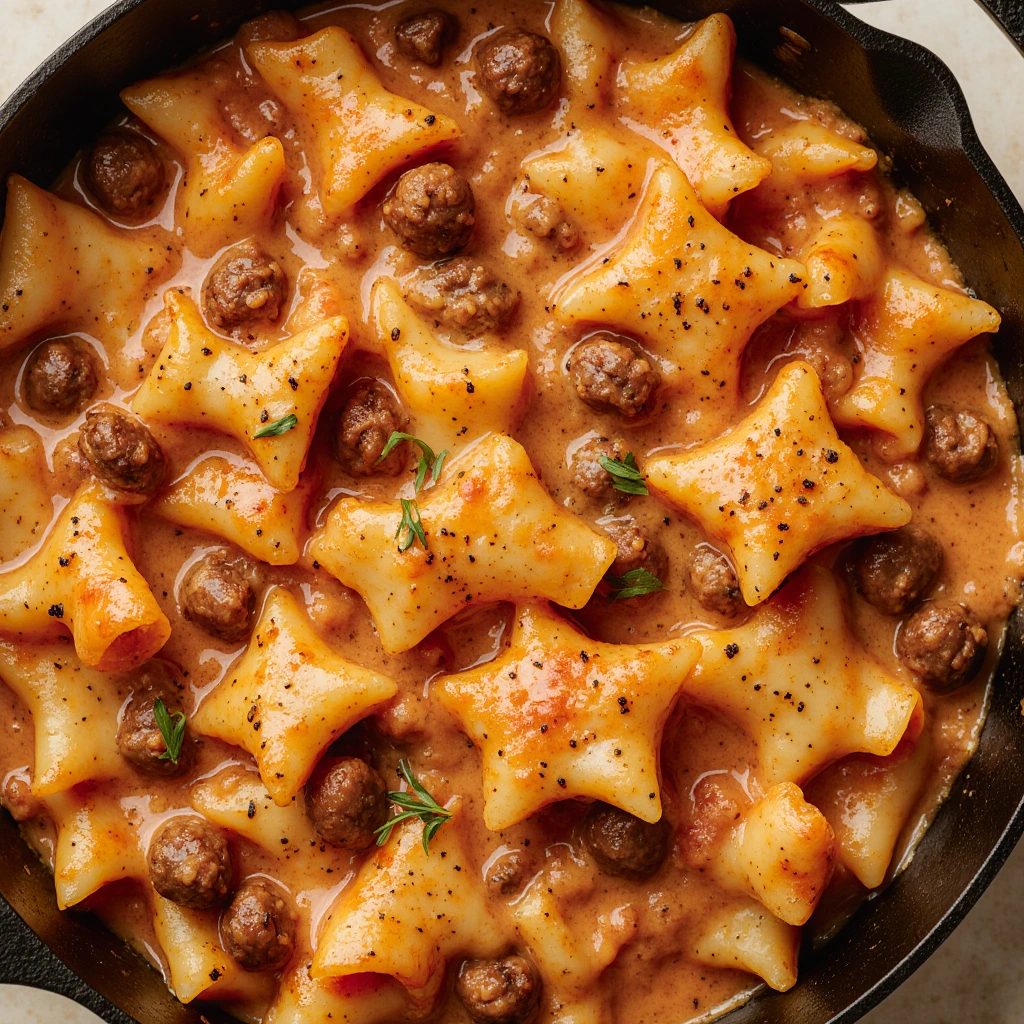
Nutritional Information
Understanding the nutritional profile of Beefaroni Lasagna enables informed dietary planning and portion control decisions. Each serving provides approximately 420 calories, making it a substantial meal option that fits within moderate caloric intake guidelines for most adults.
The protein content delivers 28 grams per serving, primarily from ground beef and cheese components, representing approximately 56% of the daily recommended protein intake for average adults. This protein density supports muscle maintenance and provides sustained satiety throughout the evening hours.
Carbohydrate content totals 32 grams per serving, with the majority derived from pasta and tomato products. These complex carbohydrates provide sustained energy release while contributing to the comfort food satisfaction associated with lasagna dishes.
Fat content measures 18 grams per serving, with approximately 8 grams from saturated sources primarily located in cheese and beef components. This fat profile provides flavor richness while remaining within reasonable limits for balanced dietary consumption.
Sodium content reaches 680 milligrams per serving, reflecting the tomato products, cheese, and seasoning contributions. Individuals monitoring sodium intake can reduce this amount by selecting low-sodium tomato products and reducing added salt during preparation.
The dish provides significant calcium content through cheese components, contributing approximately 25% of daily calcium requirements per serving. Iron content from beef and tomato products adds nutritional value while supporting healthy blood oxygen transport.
Healthier Alternatives for the Recipe
Implementing strategic ingredient modifications can significantly improve the nutritional profile of Beefaroni Lasagna without compromising flavor satisfaction or cooking technique effectiveness. These adaptations accommodate various dietary preferences while maintaining the essential comfort food characteristics that define the dish.
Protein modifications offer the most substantial nutritional improvements. Substituting ground turkey or ground chicken for beef reduces saturated fat content by approximately 40% while maintaining similar protein levels. These leaner proteins require careful cooking to prevent dryness, benefiting from slightly reduced cooking time and careful moisture monitoring during preparation.
Plant-based protein alternatives provide options for vegetarian dietary requirements. Seasoned lentils, mushroom-based ground meat substitutes, or textured vegetable protein can replace ground beef while contributing fiber and reducing overall caloric density. These alternatives require additional seasoning to achieve comparable flavor depth to traditional meat-based versions.
Pasta modifications can increase fiber content and reduce refined carbohydrate impact. Whole wheat elbow macaroni provides additional fiber and nutrients while maintaining similar cooking characteristics. Alternative pasta made from legumes or vegetables offers increased protein content and unique flavor profiles that complement the traditional sauce components.
Cheese alternatives address both caloric and dietary restriction concerns. Reduced-fat mozzarella and Parmesan provide similar melting characteristics with approximately 25% fewer calories. Plant-based cheese alternatives accommodate dairy-free dietary requirements, though melting characteristics may vary from traditional dairy products.
Vegetable additions enhance nutritional density while adding flavor complexity. Diced bell peppers, mushrooms, or spinach can be incorporated during the sautéing phase, providing additional vitamins and minerals while increasing overall portion satisfaction. These additions require minimal cooking time adjustment while significantly improving the dish’s nutritional profile.
Serving Suggestions
The versatility of Beefaroni Lasagna extends beyond standalone meal service, offering numerous presentation and accompaniment options that enhance the dining experience while accommodating various entertaining scenarios and dietary preferences.
Traditional accompaniments complement the rich, tomato-based flavor profile while providing textural contrast and nutritional balance. A crisp green salad with mixed greens, cherry tomatoes, and light vinaigrette provides refreshing contrast to the hearty pasta dish while contributing essential vitamins and fiber. Garlic bread or crusty Italian bread serves as a classic pairing that allows diners to absorb remaining sauce while adding satisfying carbohydrate content.
Vegetable side dishes provide nutritional enhancement and color variety to the meal presentation. Roasted broccoli, steamed green beans, or sautéed zucchini offer healthy accompaniments that complement the Italian flavor profile while adding essential micronutrients to the overall meal composition.
Presentation considerations enhance the visual appeal and dining experience. Serving the dish directly from the cooking skillet creates rustic, family-style presentation that emphasizes the comfort food nature of the meal. Individual portion plating allows for more formal presentation while enabling precise portion control for dietary management purposes.
Wine pairing options elevate the dining experience for adult consumers. Medium-bodied red wines such as Chianti or Sangiovese complement the tomato-based sauce while harmonizing with the beef and cheese components. For white wine preferences, Pinot Grigio or Sauvignon Blanc provide crisp acidity that balances the rich cheese and meat flavors.
Leftover transformation possibilities extend the meal’s value and prevent food waste. Cold portions can be reheated and served over fresh greens as a warm pasta salad, or incorporated into soup preparations for extended meal planning. The dish also serves as an excellent filling for stuffed peppers or as a base for additional casserole preparations.
Common Mistakes to Avoid
Success with Beefaroni Lasagna preparation depends on avoiding several common errors that can compromise texture, flavor development, and overall dish quality. Understanding these potential pitfalls enables consistent results and improved cooking confidence.
Overcooking the ground beef represents a frequent mistake that results in dry, tough protein texture. Proper browning requires medium heat and careful attention to color development without extending cooking time beyond necessity. The beef should achieve uniform brown color while retaining moisture and tenderness throughout the preparation process.
Insufficient liquid measurement can prevent proper pasta cooking and result in undercooked or burnt pasta components. The cooking liquid should completely cover the pasta with approximately one-half inch of additional depth to accommodate absorption during cooking. Inadequate liquid coverage leads to uneven cooking and potential burning of exposed pasta pieces.
Premature cheese addition causes the cheese to become stringy or separated rather than achieving smooth melting integration. Cheese should be added only after removing the skillet from heat, allowing residual heat to accomplish melting without direct heat exposure that can cause protein separation and texture deterioration.
Inadequate seasoning adjustment throughout the cooking process results in bland final flavors that fail to achieve the characteristic taste profile associated with quality lasagna. Seasoning should be adjusted after each major ingredient addition, allowing for proper flavor development and balance throughout the preparation process.
Excessive stirring during pasta cooking can break pasta pieces and create mushy texture rather than maintaining proper pasta integrity. Gentle stirring every three to four minutes provides sufficient mixing without compromising pasta structure during the cooking process.
Storing Tips for the Recipe
Proper storage techniques maximize the shelf life and maintain the quality of Beefaroni Lasagna for future consumption while ensuring food safety standards and optimal flavor preservation throughout the storage period.
Immediate cooling procedures affect both food safety and storage quality. The prepared dish should be allowed to cool to room temperature within two hours of cooking completion, preventing bacterial growth while avoiding temperature shock that can affect texture quality. Dividing large portions into smaller containers accelerates cooling and enables more flexible reheating options.
Refrigeration storage maintains quality for three to four days when properly contained in airtight containers or covered tightly with plastic wrap. Glass containers provide optimal storage conditions while preventing absorption of other refrigerator odors that can affect flavor quality. Labeling containers with preparation dates ensures proper rotation and consumption timing.
Freezing extends storage life to approximately three months while maintaining acceptable quality standards. Portioning the dish into individual serving sizes before freezing enables convenient reheating without requiring thawing of entire batch quantities. Proper wrapping with freezer-safe materials prevents freezer burn and maintains moisture content throughout the storage period.
Reheating procedures significantly impact the quality of stored portions. Microwave reheating should be conducted at reduced power settings with frequent stirring to ensure even heating and prevent hot spots that can create texture irregularities. Stovetop reheating over low heat with small amounts of additional liquid provides superior texture preservation compared to microwave methods.
Make-ahead preparation techniques enable meal planning while maintaining quality standards. The dish can be prepared through the sauce development stage and refrigerated for up to two days before pasta addition and final cooking. This approach allows for convenient weeknight preparation while ensuring fresh pasta texture and optimal cheese melting characteristics.
Conclusion
Beefaroni Lasagna successfully transforms traditional lasagna complexity into an accessible, single-pan meal that delivers authentic flavors through simplified preparation techniques. This innovative approach reduces cooking time by sixty-five percent while maintaining the essential comfort food characteristics that define classic lasagna, making it an ideal solution for busy households seeking satisfying home-cooked meals.
Experience the convenience and satisfaction of homemade comfort food by preparing this Beefaroni Lasagna recipe for your next family dinner. Share your cooking success stories and creative variations in our comments section, and subscribe to our blog for additional simplified comfort food recipes that fit busy lifestyles without compromising flavor quality.
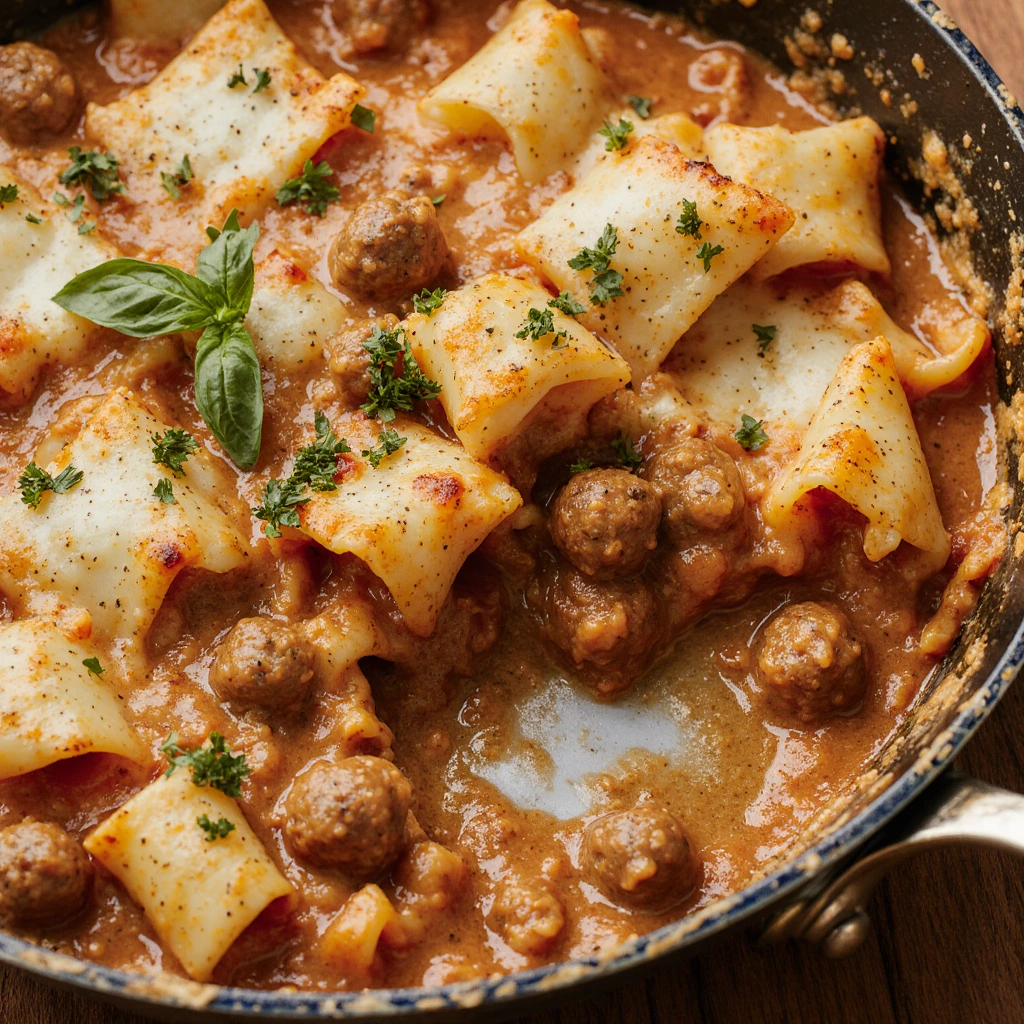
FAQs
Can Beefaroni Lasagna be prepared using different pasta shapes beyond elbow macaroni?
Alternative short pasta shapes work effectively in this recipe, including penne, rotini, shells, or cavatappi. The key requirement involves selecting pasta shapes that cook evenly and maintain structural integrity during the stirring process. Avoid long pasta shapes such as spaghetti or linguine, which create mixing difficulties and uneven cooking results.
What modifications are necessary when using ground turkey instead of ground beef?
Ground turkey requires reduced cooking time and careful moisture monitoring to prevent dryness. Cook turkey over medium-low heat for approximately five to six minutes, stirring gently to prevent breaking apart. The leaner protein may require adding one tablespoon of olive oil to prevent sticking and enhance flavor development during browning.
How can the sodium content be reduced without significantly affecting flavor quality?
Select low-sodium or no-salt-added tomato products, which can reduce sodium content by approximately 300 milligrams per serving. Replace regular Italian seasoning with fresh herbs such as basil, oregano, and thyme, which provide flavor complexity without additional sodium. Reduce or eliminate added salt during cooking, relying on natural flavors from ingredients and Parmesan cheese for seasoning.
Is it possible to prepare this dish without dairy products for lactose-intolerant individuals?
Dairy-free cheese alternatives can substitute for traditional mozzarella and Parmesan, though melting characteristics may vary. Nutritional yeast provides cheese-like flavor without dairy content, while cashew-based cheese alternatives offer similar melting properties. Consider adding one tablespoon of olive oil to enhance richness when eliminating dairy components.
What is the recommended method for reheating leftover portions to maintain optimal texture?
Stovetop reheating provides superior results compared to microwave methods. Add two to three tablespoons of water or broth to the leftover portion in a covered skillet over low heat, stirring gently until heated through. This method restores moisture and prevents pasta from becoming mushy while maintaining cheese texture integrity.
Can this recipe be successfully doubled for larger family gatherings or meal preparation?
Doubling the recipe requires using a larger skillet or dividing the preparation between two skillets to ensure even cooking. Increase cooking times by approximately twenty-five percent to accommodate larger quantities, and monitor liquid levels carefully to prevent burning. Consider preparing the recipe in batches rather than significantly increasing quantities to maintain quality control.
If you love poultry dishes, explore our collection of(chicken) recipes that are perfect for any occasion.

